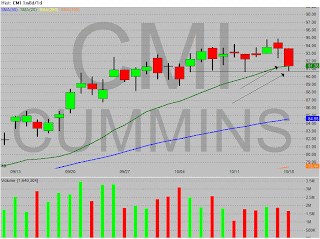Overshoot Strategy Again
Overshoot Strategy
Overshoot Strategy Example
How to catch a knife properly
When a stock is nearing support (in this case the 20SMA) but it's not showing signs of reversing, look for an overshoot of primary support and into secondary support. On entry on reversal on secondary support the first target is a move back to primary support.
In this case CMI had 20SMA near 91.4 and secondary support near 90.68-90.83 level.
At 91.4/20SMA zone there was a small reversal, we got in with stop on the low and quickly lost 12 cents as stock reversed down to make new low. Once this happens you have to sit back and wait for secondary support to hit. The set-up for the secondary support overshoot was actually much better -- a panic move away from the EMA with a big volume spike. We were ready to buy support anywhere from 90.6-90.9. Target exit is a move back to primary support which was 91.4/ 20SMA, anything after that is a bonus. In this example reward target was 50 cents and stop was only 10-15 cents (fills from 90.85-90.9 were easy) Very good risk-reward.
If your trade is working well and you want to stay past the major exit point of primary support then sell majority of position into the target, and hold remaining position with either original stop or stop at break-even.
It's one of the more difficult strategies we have in our toolbox but it can be very satisfying. A couple of conditions before trying it: 1) You have to be fast and be able to take a quick loss without blinking. 2) You have to be patient and wait for the secondary support to be hit before entering and most important 3) You can only enter this strategy if secondary support is hit very extended from the EMA/base. If it's close to the EMA/base then chances are it's just going to grind lower. Never buy the grind lower on these type trades, always wait for the panic spike.




























 65.26
65.26




















